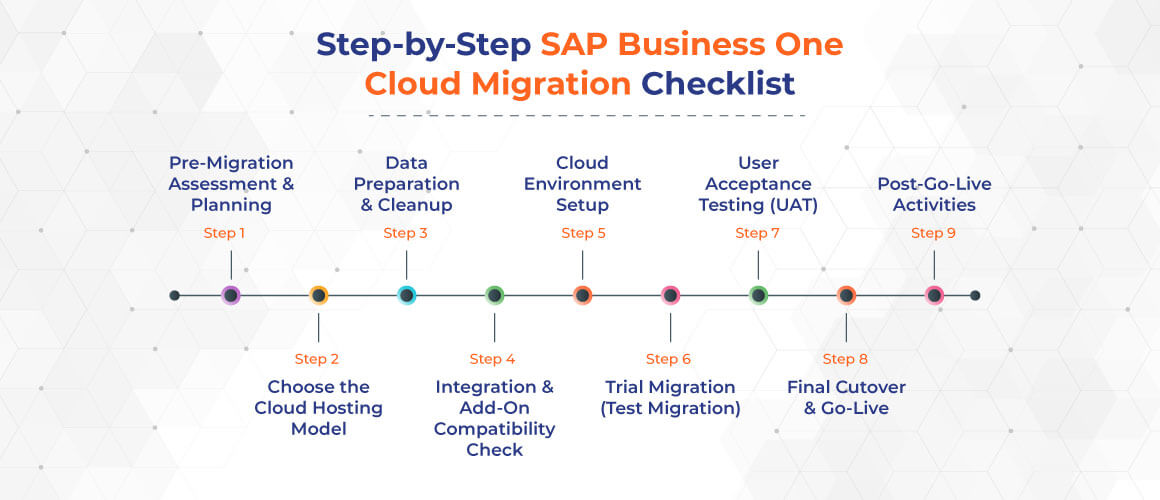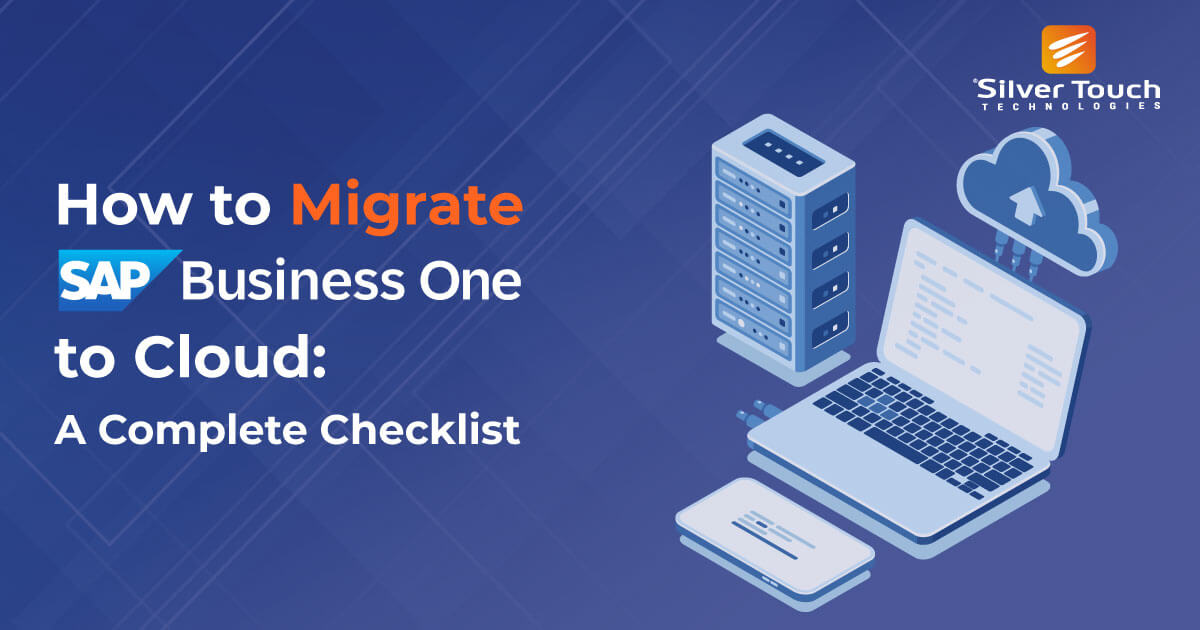The UK witnesses an exponential growth in its economy and industrialisation. In such a scenario, no small to medium-sized enterprises (SMEs) can afford to miss the opportunity. However, these enterprises must adopt cloud technology to address the infrastructure constraints and maintenance hurdles of on-premise infrastructure. This is one of the major reasons why many businesses move SAP B1 to cloud.
This blog gives the UK SMEs a step-by-step migration checklist for moving their existing SAP Business One on-premise system to the flexible SAP Business One cloud. An effective SAP Business One Cloud migration offers the benefits, like cost-effectiveness, modernisation, and improved performance. Let’s start with some indicators that show your business is ready for SAP B1 Cloud.
Key Indicators Your Business is Ready for SAP B1 Cloud
It is always crucial to recognise the right time to move SAP Business One to cloud. If your UK SME is experiencing any of the following issues, the time is just right to shift your SAP B1 on-premise to the cloud.
Growth in Remote Workforce
Slow and clunky VPN access to the on-premise system creates hurdles in work-from-home or hybrid models. As the remote workforce grows, it is necessary to move SAP Business One to cloud.
Issues of Legacy Hardware
If an existing server infrastructure is exhausting, it requires either a costly hardware refresh cycle or switching to the cloud. Here, opting for SAP Business One Cloud hosting is a more viable consideration.
Need for Cloud-Native Integration
Cloud-native or modern applications like Microsoft 365 and Shopify need modern and seamless integration of your business model into the cloud. SAP Business One On-premise to Cloud transition can meet this need.
Disaster Recovery Challenges
If your current Disaster Recovery (DR) plan is untested and inadequate, it can leave your business vulnerable. As the SAP B1 cloud migration checklist has all the robust solutions, you can address these disaster recovery-related challenges.
Overloaded IT Teams
When your IT team has to spend too much time on routine maintenance and backups while managing physical security, you should consider the cloud option. It can help them focus on other important tasks.
Sluggish Performance and Downtime
Unplanned downtime due to hardware faults or maintenance issues can be costly for your enterprise. In such a situation, you should improve infrastructure by adopting SAP Business One Cloud migration.
Your existing SAP Business One on-premises solution can meet business requirements and simplify complexities effectively. However, when it comes to the expansion of your business, it is better to switch to the cloud option.
Benefits of Moving SAP Business One to the Cloud
A successful SAP Business One Cloud migration is highly beneficial for modern enterprises. As a strategic investment, this move offers the following improvements immediately-
Reduced Costs
It eliminates the need for expensive server hardware refreshes and physical security. It converts CapEx into predictable OpEx successfully.
Better Performance
As compared to physical environments, cloud environments perform better for reporting data and making transactions.
Higher Uptime
Industry-leading Service Level Agreements (SLAs) ensure business continuity. A reputable managed cloud service providers ensure higher uptime.
Automatic Backups
Automated backups with secure off-site data storage can reduce the risk of data loss. Cloud providers offer robust backup and storage facilities.
Improved Security & Compliance
Companies can access enterprise-grade physical and cyber security compliant with UK standards by migrating to the cloud.
More Scalability
Cloud technology enables companies to scale up or down computing power, storage, and memory instantly to meet changing business requirements.
Remote Accessibility
Companies can access the SAP B1 ecosystem securely from any location and on any device effectively.
These benefits show the importance of migrating the on-premise SAP B1 system to the cloud. However, companies need to follow the SAP B1 cloud migration checklist to leverage these benefits with a more resilient operational structure.
Step-by-Step Migration Checklist
It is essential to follow the migration checklist to minimise disruption and ensure data integrity within the new cloud-based SAP B1 environment. Let’s go through the various steps of SAP B1 cloud migration checklist.

Step 1: Pre-Migration Assessment & Planning
This is an initial stage that defines the core objectives of the migration process, including remote working and infrastructure costs. The second action is to review the existing SAP B1 version, modules, and add-ons. The third action item is to document customisations by making a list of tailored reports, stored procedures, and user-defined fields (UDFs). Next action is to check the system with all third-party add-on vendors for compatibility.
After completing all these actions, companies can define the migration scope with the help of a SAP Business One Cloud hosting provider. The following checklist shows the first step-
| Action Item | Team | Status |
|---|---|---|
| Identify Core Objectives | CIO/Business Owner | □ |
| Review Existing SAP B1 Version | IT Manager/Partner | □ |
| Document Customisations | IT or Key Users | □ |
| Validate Add-on Compatibility | Cloud Partner/Vendor | □ |
| Define Migration Scope | Project Team | □ |
Step 2: Choose Cloud Hosting Model
It is necessary to select the correct cloud hosting model to gain an advantage in the long term. It starts with subscribing to a full SAP Business One Cloud from an official SAP Partner. Then you can choose from either private cloud or public cloud (IaaS- Infrastructure-as-a-Service), like Azure or AWS.
Here is a checklist for choosing the right cloud hosting model-
| Action Item | Responsible Team | Status |
|---|---|---|
| Confirm UK/EU Data Residence | IT Manager/Partner | □ |
| Review Uptime SLAs | IT Manager | □ |
| Understand Backup & DR | IT Manager/Partner | □ |
| Check Hardware Specifications | Partner | □ |
The next crucial step is data preparation and cleanup before migration.
Step 3: Data Preparation & Cleanup
Clean data is imperative for ensuring a smooth transition and post-go-live stability. Here is a checklist for data preparation when you move SAP Business One to cloud-
| Action Item | Responsible Team | Status |
|---|---|---|
| Clean Master Data | Key Users/Finance | □ |
| Remove Duplicates | IT/Partner | □ |
| Validate Financial Periods | Finance Team | □ |
| Archive Historical Data | IT Manager | □ |
| Prepare Extraction List | Partner | □ |
The next step is the integration of data, with checking the compatibility for add-ons.
Step 4: Integration & Add-On Compatibility
This step addresses the necessities of finding compatibility with SAP B1 cloud and other business systems or add-ons. It is necessary for ensuring a successful SAP Business One on-premise to cloud migration. Here is a checklist for it-
| Action Item | Responsible Team | Status |
|---|---|---|
| Map Integrations, like CRM and MS Office 365 | IT/Partner | □ |
| Check Connector Compatibility | Partner/Vendor | □ |
| List API Dependencies | IT/Developer | □ |
| Validate Add-Ons for Cloud Version | Partner /Vendor | □ |
Once this step is over, you can move to the setup of the cloud environment.
Step 5: Cloud Environment Setup
It is a step involving the technical configuration of the new cloud platform. Here is the checklist to make it ready for the data migration.
| Action Item | Responsible Team | Status |
|---|---|---|
| Provisional Cloud Environment | Partner/Host | □ |
| Install SAP B1 | Partner | □ |
| Configure Database (SQL/HANA) | Partner | □ |
| Create Users and Access | IT Team/Partner | □ |
| Apply Security Controls | Partner/IT Team | □ |
The next step after this is the dress rehearsal of the cloud migration.
Step 6: Trial Migration (Test Migration)
This is a non-negotiable step because it proves the concept and identifies errors before final implementation. Here is the SAP B1 Cloud migration checklist for this vital step-
| Action Item | Responsible Team | Status |
|---|---|---|
| Platform Sandbox Migration | Partner | □ |
| Validate Master & Transactional Data | Key Users/Finance | □ |
| Test Integrations | IT/Partner | □ |
| Run Performance Checks | Partner/Key Users | □ |
| Fix Migration Errors | Partner | □ |
All these tests and performance checks lead to user acceptance testing of the SAP B1 Cloud solution.
Step 7: User Acceptance Testing (UAT)
This step invites your team to sign off on the new system. It is necessary to understand its functionality thoroughly.
| Action Item | Responsible Team | Status |
|---|---|---|
| Test Daily Transactions | Key Users | □ |
| Validate Workflows | Key Users | □ |
| Review Reports | Finance/Management | □ |
| Approve Cutover Plan | Project Sponsor | □ |
Once this step is over, you can go live with your solution.
Step 8: Final Cutover & Go-Live
This step is mostly taken over a weekend to avoid any disruption in routine processes. Here is a checklist for the final cutover and go-live step-
| Action Item | Responsible Team | Status |
|---|---|---|
| Stop Data Entry on the On-Premise System | All Users | □ |
| Perform Final Migration | Partner | □ |
| Validate Opening Balances, Inventory, etc. | Finance/Key Users | □ |
| Activate Live Integrations | Partner/IT | □ |
| Train Users | Project Team/Partner | □ |
| Update System URLs | IT Manager | □ |
After initiating the cloud version, it is essential to give it extensive technical assistance with continuous monitoring.
Step 9: Post-Go-Live Activities
Post-go-live activities include support and monitoring to avoid any issues after initiating the SAP B1 Cloud version. It involves the following aspects-
| Action Item | Responsible Team | Status |
|---|---|---|
| 48-Hour Hypercare | Partner/Project Team | □ |
| Validate Report’s Accuracy | Finance | □ |
| Monitor System Performance | Partner/IT | □ |
| Additional Training | Partner | □ |
| Set Backup Schedules | Partner/IT | □ |
SAP Business One Cloud migration is a complex process and requires domain expertise with other technical skills. This exhaustive SAP B1 cloud migration checklist will help you implement all the steps in a proper order. It is better to consult a trusted SAP Business One Cloud hosting provider to know more about this checklist.
Security & Compliance
Superior security, high scalability, and better compliance management are primary drivers for many UK-based businesses to move SAP Business One to cloud. However, it is essential to pay special attention to UK-specific regulations during SAP B1 Cloud migration. Apart from choosing the right SAP Business One Cloud hosting solution, you need to consider several compliance and security-related requirements.
First things first. It is essential to ensure a formal Data Processing Agreement (DPA) is in place with the cloud hosting provider that defines responsibilities under the UK GDPR act. Moreover, many UK-based SMEs prefer to have their data physically stored within the UK or EU borders to simplify legal monitoring. Another important factor is encryption. All sensitive data should have TLS/SSL encryption in transit and AES-256 when at rest.
It is crucial to implement multi-factor authentication (MFA) for all applications and system access. A role-based access control (RBAC) within SAP B1 is also necessary. You need to define a strict Recovery Point Objective (RPO) and Disaster Recovery (DR) to define the maximum acceptable data loss and downtime, respectively. Finally, you need to maintain comprehensive and tamper-proof audit logs for the cloud environment.
Implementing these measures within a new SAP Business One Cloud hosting environment can help your company mitigate risks and follow national data protection standards.
Cost Considerations
The cloud has a completely different financial model than that of an on-premise solution. Companies can shift their expenditure from large upfront capital costs (CapEx) to predictable operational costs (OpEx) every month. Here is an important checklist consisting of various cost factors and the UK price range.
| Cost-Determining Factor | Description | UK Price Range (Monthly/One-Off) |
|---|---|---|
| Cloud Hosting | Monthly fee for the cloud server resources, network, monitoring, and infrastructure management | Varies based on size and SQL/HANA |
| Licensing Updates | The cost of transitioning from owned Perpetual Licences to Subscription Licenses | £35 – £100 per user/month (SAP B1 license + Cloud access) |
| Migration Service | The one-off fee charged by the SAP Partner that covers planning, data cleansing, migration, and go-live support | £8,000 – £25,000+ (One-off, depends on complexity) |
| Add-on Compatibility | Fees to update, re-license, or re-engineer any essential third-party add-ons | Variable |
| Training | Cost for re-training users on cloud access methods and minor UI changes | £500 – £3,000 (One-off) |
| Monthly Subscription | The predictable total recurring fee post migration | £500 – £3,000+ per month (Varies based on user count and service level) |
Calculation of these figures can give you an idea of the long-term TCO benefits of SAP B1 Cloud migration. Let’s understand the timeline of migration to the cloud through simple examples.
Example Migration Timelines
Complexity is the key element of the SAP B1 Cloud migration process. Typically, a small setup with up to 10 users and minimal customisation can take at least 2 to 3 weeks from planning to go-live. A medium setup consists of 10 to 30 users with moderate customisation, and two or three integrations can take 4 to 6 weeks. A complex setup for over 30 users and multiple third-party add-ons requires 6 to 10 weeks to ensure effective data migration.
It is better to consult a trusted SAP Business One cloud hosting provider with your requirements to get an exact duration of migration.
Concluding Remarks
SAP B1 on-premise solution is highly beneficial for SMEs, but the cloud version can offer more scalability and cost-effectiveness. However, it is necessary to follow the SAP B1 cloud migration checklist properly to leverage the benefits of cloud-based solutions.
Hope this comprehensive guide to SAP B1 migration to cloud will help you ensure a proper implementation of an advanced solution.
Silver Touch- Technologies UK is a renowned SAP Business One cloud solutions provider. Our in-house team of certified SAP developers can assist you at every stage of migration of SAP B1 on-premise to cloud. Contact us to learn more about our SAP Business One services.
FAQs
SAP Business One Cloud is the cloud-hosted version of SAP B1 that offers faster performance, remote access, lower hardware costs, automated backups, and stronger security. Companies move to it to reduce IT maintenance, improve scalability, and enable modern digital workflows without large infrastructure investments.
You’re ready for SAP B1 Cloud if your infrastructure is outdated, your workforce is remote or multi-location, you face performance issues, or you need better integration with eCommerce, CRM, or reporting systems. If manual work and downtime are increasing, cloud migration becomes essential.
Key steps include evaluating your current SAP B1 environment, selecting a hosting model, preparing and cleaning your data, checking integration compatibility, setting up the cloud environment, performing a test migration, conducting UAT, and completing final cutover with post-go-live monitoring.
Most SMEs complete the migration in 2–6 weeks, depending on data volume, number of integrations, customisations, and user training needs. Simple environments may migrate within 2–3 weeks, while more complex setups may take longer.
Most core data, modules, and standard integrations work seamlessly after migration. However, certain add-ons or custom integrations may require compatibility checks or adjustments. That’s why pre-migration assessment and a trial migration are essential parts of the process.





